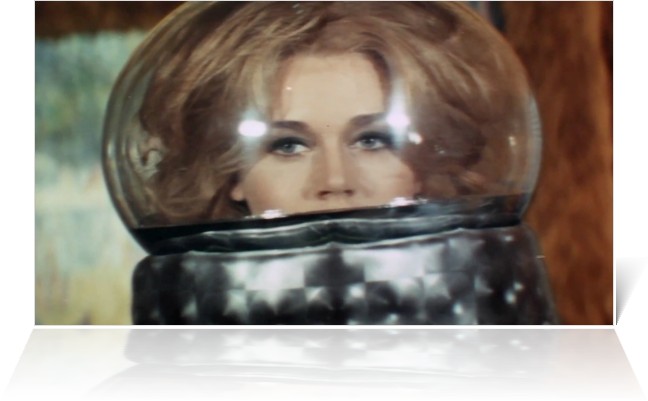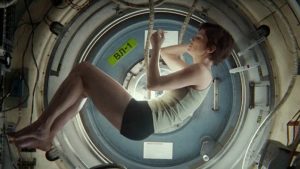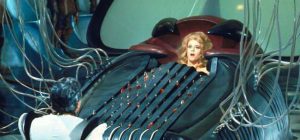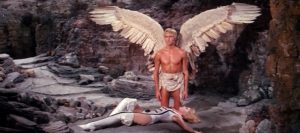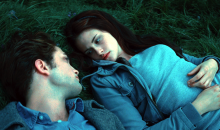Barbarella
An iconic film is usually influential for a reason. Jaws was a summer blockbuster at a time when no one was making summer blockbusters. Star Wars was a successful space opera at a time when no one made successful space operas. The Matrix was successful for its innovative fight scenes, with the now-famous “bullet time” sequences.
Looking back on certain movies, it’s easy to determine why that movie reached iconic status. Other movies are harder. A few of Stanley Kubrick’s movies fall into the second column for me. I can see without too much difficulty why The Shining was groundbreaking, but Spartacus is trickier. Where some see a classic, I only see an overlong sword-and-sanded story and I fall asleep before the third act.
Which brings me to the subject of today’s Way Too Late Review: Dino De Laurentiis’s 1968 sexpot space romp Barbarella. The film that launched Jane Fonda’s career, gave Duran Duran a kickass band name, and inspired the costumes of The Fifth Element. The film that seems to follow Sandra Bullock’s career around like a happy puppy, whether Bullock has virtual sex in Demolition Man like Barbarella does, or strips in zero gravity in Gravity, emulating Barbarella’s infamous opening credits.
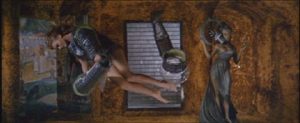
What made Barbarella so influential? Why all the homages littered through pop culture of the last fifty years? It’s not that the film was financially successful, making less than $3 million on a $9 million budget. Plot-wise Barbarella is a bit of a mess. Based on the comic book of the same name, Barbarella stars Jane Fonda as the titular character, an astronaut from Earth’s far future. Barbarella is tasked by the President of Earth to locate and rescue Durand Durand, a scientist and inventor of the Posatronic Ray, a deadly weapon. Barbarella travels to the Tau Ceti system, where she learns that Durand Durand can be found in Sogo, City of Night. In her travels to find Durand Durand she is attacked by living dolls, rides on a sledge pulled by a space manta ray, befriends the blind angel Pygar (John Phillip Law), battles the Great Tyrant, and has lots and lots of sex.
That last point is important, because on the surface, Barbarella is nothing more than a sexploitation film, designed to showcase as much of Jane Fonda’s body as possible. During the opening credits she strips down to nothing, covered only by a set of bouncing title cards and accompanied by the most amazing trumpet solo I have ever heard. Fonda’s costumes are designed to expose as much flesh as possible; one outfit even features a plastic top that is see-through over one breast. One plot point involves Barbarella being trapped in the Excessive Machine, designed to make someone to orgasm to death.
But beyond all the titilation is something bigger: a science-fiction film where many of the characters are women. I’ve blogged before about how hard that is to come by in 2015. And while movie studios today seemingly turn a deaf ear to audiences’ pleas for stronger female roles, 1968 gave us a movie where both the protagonist and antagonist were smart, tough, capable women. The men of Barbarella are sidekicks and many are flawed in one way or another, from the leader of the resistance Dildano (David Hemmings), who bumbles and stumbles his way through an attempted overthrow of the Great Tyrant, to Pygar, the blind angel who is hobbled at the beginning of the story by his psychological inability to fly.
Barbarella spends a good portion of the movie sleeping with the male aliens she encounters, true. But this film took place in the middle of the sexual revolution, when attitudes about what was and wasn’t acceptable for women to do were changing. Moreover, Barbarella doesn’t feel morally guilty about her sexuality at all. To be naked is simply a state of being, and to feel good is only natural. The best science fiction holds a mirror up to current society. Star Trek: The Original Series did this in spades, using the backdrop of the 23rd century to comment on race relations, gender, and ethnicity. Barbarella does the same, only more focused on challenging the sexual norms of the day.
In the age of the naked celebrity selfie, always-available internet porn and World Naked Bike Rides, it’s easy to forget that such things were taboo less than fifty years ago. For that reason I recommend watching Barbarella. Today’s camp is yesterday’s scandal, and it’s important to see what the mirrors of society used to show.
tl;drs
Quick summary: Barbarella must travel to the city of Sogo to rescue the scientist Durand Durand. Along the way she meets (and sleeps with) various male aliens.
Too many writers? Barbarella wins first place for having too many writers. IMDB credits 9 writers, while sources on Wikipedia put the number as high as 14.
Recommended if you like: Xanadu, Star Trek: The Original Series, strong female characters
Better than I expected? The costume and set design must be seen to be believed.
Would it work better in a different medium? A sequel/remake has been discussed for decades, but has never gotten out of development hell.
Verdict: Campy by today’s standards, Barbarella is a must watch for people interested in knowing one of the origin stories of pop culture.
Related Viewing: Two music videos that pay homage to Barbarella’s famous opening scene: “Put Yourself in My Place” by Kylie Minogue and “They” by Jem.

